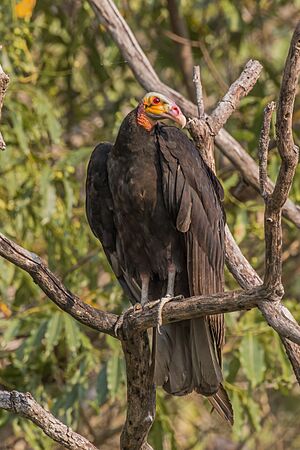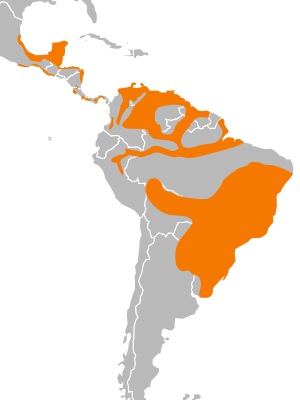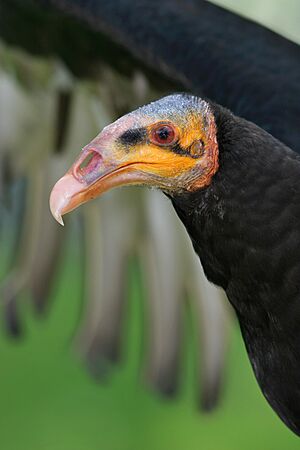Lesser yellow-headed vulture facts for kids
Quick facts for kids Lesser yellow-headed vulture |
|
|---|---|
 |
|
| C. b. urubtinga in the Pantanal, Brazil |
|
| Conservation status | |
| Scientific classification | |
| Genus: |
Cathartes
|
| Species: |
burrovianus
|
 |
|
| Breeding range of C. burrovianus | |
The lesser yellow-headed vulture (Cathartes burrovianus) is also known as the savannah vulture. It is a type of bird from the New World vulture family, Cathartidae. For a long time, people thought it was the same as the greater yellow-headed vulture. But in 1964, scientists realized they were different species.
You can find this vulture in Mexico, Central America, and South America. It lives in places that are wet or flooded for part of the year, like grasslands, swamps, and areas where forests used to be. It's a big bird, with a wingspan of about 150 to 165 cm (59 to 65 in). Its body is black, but its head and neck have no feathers. These parts are usually pale orange with red or blue spots. This vulture can only make grunts or low hisses because it doesn't have a special voice box called a syrinx.
Lesser yellow-headed vultures eat dead animals, also known as carrion. They find food using both their excellent eyesight and their sense of smell. This strong sense of smell is quite rare in birds. They often rely on bigger vultures, like the king vulture, to open up the tough skin of large dead animals. This is because their own beaks aren't strong enough. Like other New World vultures, they use warm air currents called thermals to fly high without much effort. They lay their eggs on flat surfaces, such as cave floors or inside hollow tree stumps. When their babies hatch, the parents feed them by regurgitating (bringing up) food they have already eaten.
Contents
Understanding the Lesser Yellow-Headed Vulture
Naming and Types
The lesser yellow-headed vulture was first described in 1845 by a person named John Cassin. Sometimes, scientists recognize two different types, or subspecies, of this vulture.
One type is called Cathartes burrovianus urubitinga. It was described in 1851 and is a bit larger. You can find it from Argentina all the way north to Colombia. The other type is the nominate subspecies, Cathartes burrovianus burrovianus. This one is smaller and lives from northwestern South America through Central America to Mexico.
The word Cathartes, which is part of the vulture's scientific name, means "purifier." It comes from an ancient Greek word. The common name "vulture" comes from a Latin word meaning "tearer," which describes how these birds eat.
Scientists are still trying to figure out the exact family tree for the lesser yellow-headed vulture and other New World vultures. Even though New World vultures and Old World vultures look similar and do similar jobs in nature, they actually evolved from different ancestors in different parts of the world. Some scientists even thought New World vultures were more closely related to storks! Today, most agree they are in their own special group.
What Does the Lesser Yellow-Headed Vulture Look Like?
The lesser yellow-headed vulture is the lightest and smallest of the New World vultures that are still alive today. It is about 53 to 66 cm (21 to 26 in) long. Its wings can spread out to 150 to 165 cm (59 to 65 in). It weighs between 0.95 and 1.55 kg (2.1 and 3.4 lb).
Its feathers are black with a green shine. The throat and sides of its head have no feathers. The skin on its head and neck is yellow, with a reddish forehead and the back of its neck. The top of its head is gray-blue. Its eyes have red centers, its legs are white, and its beak is a flesh color. It has a single row of eyelashes on its upper eyelid and two rows on its lower lid.
The tail of this vulture is rounded and fairly short. When its wings are folded, the tips go past its tail. Young lesser yellow-headed vultures have browner feathers and a darker head.
Its beak is thick, rounded, and hooked at the end. Its front toes are long with small webs, but they aren't good for grabbing things. The opening of its nostril is long, and its nostrils don't have a dividing wall. Like all New World vultures, it cannot make loud calls because it lacks a voice box (syrinx). It can only make a low hiss.
This vulture looks a bit like the greater yellow-headed vulture and the turkey vulture. However, the lesser yellow-headed vulture is smaller and less bulky than the greater yellow-headed vulture. Its feathers are browner, and its legs are lighter. Its head is also more orange, while the greater yellow-headed vulture's head is more yellow. The lesser yellow-headed vulture also prefers to live in open grasslands, unlike the greater yellow-headed vulture which likes forests.
Where Do They Live?
You can find the lesser yellow-headed vulture in many countries. These include Argentina, Belize, Bolivia, Brazil, Chile, Colombia, Costa Rica, Ecuador, El Salvador, French Guiana, Guatemala, Guyana, Honduras, Mexico, Nicaragua, Panama, Paraguay, Peru, Suriname, Uruguay, and Venezuela.
Its favorite places to live are subtropical or tropical areas. These include grasslands that get wet or flooded, swamps, mangroves, and old forests that have been changed by humans. It can also sometimes be seen over dry fields and open areas. It usually doesn't live in high mountains.
In Uruguay, there's a place called the Quebrada de los Cuervos (Crows Ravine). This bird, which looks a bit like a crow, helped name the ravine. Lesser yellow-headed vultures live there along with black vultures and turkey vultures.
Life and Habits
The lesser yellow-headed vulture usually flies alone. It holds its wings in a "V" shape, which is called a dihedral position. It glides low over wet areas while looking for food. When it rests, it often perches on fence posts or other low spots. It rarely flies in groups. This vulture uses warm air currents, called thermals, to stay in the air without flapping its wings much. It usually flies at low heights, not very high up. Scientists think this bird might move to different places depending on how much water is in its habitat.
Reproduction
Lesser yellow-headed vultures don't build fancy nests. Instead, they lay their eggs on the ground, on cliff ledges, inside caves, or in hollow parts of trees. Their eggs are cream-colored and have many brown and gray spots, especially on the wider end. They usually lay two eggs at a time.
When the chicks hatch, they are altricial. This means they are born blind, have no feathers, and can't move around much on their own. They grow their soft, fluffy down feathers later. The parent vultures feed their young by regurgitating (bringing up) food that they have already partly digested. The chicks then drink this food from their parents' beaks. The young vultures are ready to fly after about two to three months.
Feeding Habits
The lesser yellow-headed vulture is a scavenger, which means it eats mostly dead animals. It will eat roadkill or the body of any animal it finds. Sometimes, it might even hunt for food, especially small water animals in marshy areas. It doesn't usually go for very large dead animals. It might also eat live bugs, larvae, and possibly frogs, as well as smaller pieces of dead animals. Records show they eat small mammals, snakes, other reptiles, and especially rotting fish.
They prefer fresh meat. However, their beaks aren't strong enough to tear through the tough skin of larger animals. So, they often can't make the first cut into a big carcass. The lesser yellow-headed vulture will stop eating a dead animal once the meat is too decayed and has harmful germs. Like other vultures, these birds are very important for the ecosystem. They help clean up dead animals, which stops diseases from spreading.
The lesser yellow-headed vulture finds food using its sharp eyesight. But it also uses its amazing sense of smell, which is rare for birds. It can smell a gas called ethyl mercaptan, which is produced when dead animals start to decay. The part of its brain that handles smells is very large compared to other animals. Humans have even used this special ability! Sometimes, ethyl mercaptan is put into pipelines. Engineers then follow the vultures to find leaks in the pipes.
King vultures, which can't smell dead animals well, often follow lesser yellow-headed vultures to carcasses. Once they get there, the king vulture uses its strong beak to tear open the animal's skin. This allows the smaller lesser yellow-headed vulture to get to the meat, as its own beak isn't strong enough for large animals. This is a great example of how different species can help each other. However, turkey vultures and king vultures are larger, so they usually push the lesser yellow-headed vulture away from food.
Conservation Status
The lesser yellow-headed vulture is listed as a bird of Least Concern by the IUCN. This means that its population is not currently in danger. Scientists estimate that its global range (the area where it lives) is about 7,800,000 square kilometers (3,000,000 sq mi). There are thought to be between 100,000 and 1,000,000 individual birds. Its population seems to be stable, which is good news for this important scavenger.





